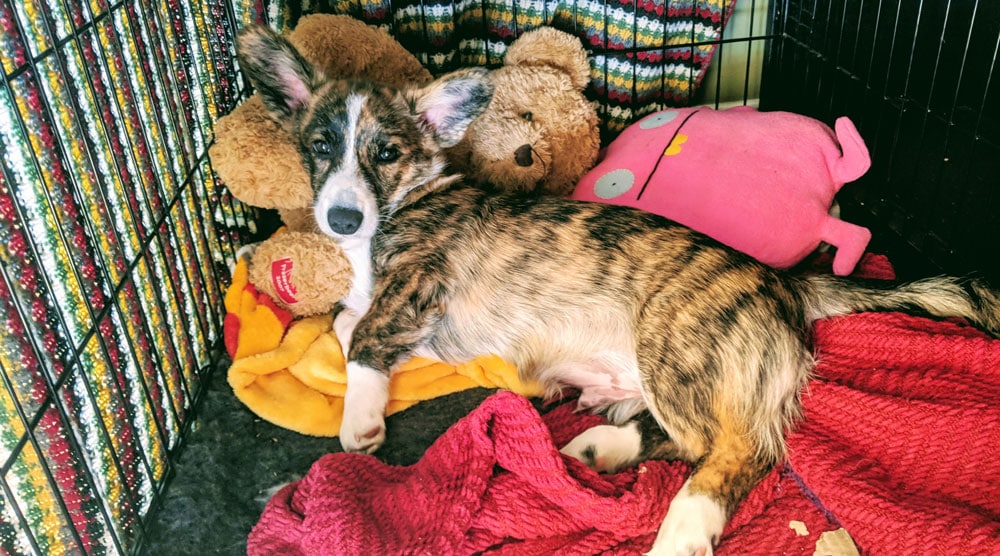Dog crates can be a helpful training tool. But it’s essential that your dog feels physically comfortable and emotionally secure inside their crate. With that in mind, is covering the crate with a blanket a good idea?
The quick answer is that many dogs (although not all) feel more secure when the crate is partially covered. Regardless of whether you use a blanket, sheet, or purpose-made cover, being enclosed can reduce anxiety and make your dog feel less exposed.
However, you should never fully cover the crate. At least one side should always be open for ventilation and to allow your dog to see their surroundings. It’s also important to check that the crate interior doesn’t get too warm.
Contents

The Quick Answer…
- Partially covering a dog’s crate with a blanket can create a “den-like” environment, helping some dogs feel more secure and relaxed.
- Never fully cover the crate though. At least one side should remain open for ventilation and visibility.
- Benefits of partially covering the crate include reduced sensory input, less light, noise muffling, and warmth during cold months.
- Not all dogs like a covered crate. It’s important to monitor your pet for signs of stress (such as lip licking) and adjust accordingly.
- Use breathable fabric, avoid thick covers or heat sources, and be cautious with chewers or dogs prone to overheating.
What Are The Benefits of Partially Covering Your Dog’s Crate With a Blanket?

There are many reasons why your dog might prefer a covered crate. Here are a few examples:
- Adding a cover to your dog’s crate can make it feel like a safe “den.” Dogs often feel most relaxed in a partially enclosed environment, as they instinctively want to find a secure area to sleep.
- Reducing sensory inputs can make it more likely that your dog relaxes, as they are less likely to be overstimulated by the surrounding environment. For example, if your dog often barks at things outside, covering up the side facing a window may help.
- A cover can reduce the amount of light inside the crate, which makes it easier for the dog to sleep.
- Covers can muffle external noises, which may help some dogs to relax. However, this effect is minor, as you shouldn’t use a thick cover.
- A cover can provide a warming effect inside the crate, which can be useful during the cold winter months.
Not all dogs enjoy a covered crate though. For example, some dogs feel stressed if they can hear something nearby but can’t see it through the cover. Others may try to chew the cover, which can be a serious choking hazard.
So, watch for signs of stress when you add a cover to the crate. Common examples include lip licking, reluctance to enter the crate, and inability to relax.
If your dog doesn’t enjoy a crate cover, then there’s nothing wrong with removing it. A cover is an optional extra for crate training and isn’t required for all dogs.
Is It Safe To Cover a Dog’s Crate With a Blanket?
Crate covers can provide a range of benefits, but it’s essential to ensure that the cover is safe and comfortable for your dog.
The most important point is that you should never fully cover the crate. Even a thin blanket can prevent airflow, so at least one side should always be uncovered. A fully covered crate is also stressful for the dog, as their vision is completely obscured.
Here are some other safety tips for crate covers:
- The best covers are made from breathable fabric. These fabrics allow air to flow into the crate, while creating a den-like environment. Cotton and microfibre blankets are two of the best examples.
- The cover shouldn’t be near or touching a heat source, such as radiators. Aside from causing the crate to become warm, this can also risk a fire. You should never place the crate in a position that receives direct sunlight.
- Avoid covering the crate with thick fabrics. These prevent any airflow and are too warm for most situations.
- Be extra careful in hot weather. The cover can trap heat inside the crate, making it uncomfortable for your pet. Brachycephalic dogs (such as pugs and bulldogs) are most at risk of overheating, but any dog can get too hot.
- Don’t use blankets with threads that fall into the crate. Your dog may try to pull or eat them, which can be a choking hazard. This is particularly important during the puppy teething phase or if your dog is a chewer.
- Chewers or destructive dogs may be more distracted by the blanket than other canines. It’s often safest not to use a cover with these pets.
It’s worth noting that you don’t need to use a blanket or sheet to cover a crate. There are also commercial crate covers, which often provide a better fit and are designed to allow airflow. Many people also prefer the appearance of fitted covers, as they are available in a range of styles and colours.
How to Introduce a Crate Cover to Your Dog
Even if your dog is comfortable inside their crate, you shouldn’t just add a cover and hope for the best.
The sudden change from an open to a covered crate can cause some dogs to feel anxious. Just like with initial crate training, it’s important to introduce the cover in a gradual and positive manner.
Start by adding the cover when the dog isn’t in the crate. Then allow your pet to explore it in their own time, giving treats and praise when they go near or inside the crate. Once your dog is going in and out of the crate without prompting, then they are probably happy with the cover.
If you want to take things even slower, you can start by covering up a single side of the crate. When your dog is comfortable with this, you can fold the cover to another side.
Important: Never cover up your dog’s crate as a punishment or to stop them from barking. Aside from being very cruel, this type of negative experience can ruin any sense of sanctuary inside the crate.
Summary
There’s nothing wrong with partially covering your dog’s crate, as long as you ensure that the cover is safe and not causing stress.
In fact, many dogs prefer an enclosed environment for resting. A covered crate can feel more like a “den”, which provides a sense of security.
It’s important not to cover the entire crate though. This doesn’t allow any airflow into the crate, and can be stressful for your dog. You should also use a breathable fabric and avoid placing the cover near a heat source.
Do you have any questions about whether you should cover your dog’s crate with a blanket? Please let us know in the comments.
